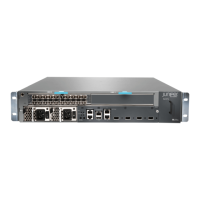•
Calculating Power Budget and Power Margin for Fiber-Optic Cables on page 69
•
Routing Engine Interface Cable Specifications for MX5, MX10, MX40, and MX80
Routers on page 71
Determining Transceiver Support and Specifications for M Series and T Series Routers
You can find information about the pluggable transceivers supported on your Juniper
Networks device by using the Hardware Compatibility Tool. In addition to transceiver
and connector type, the optical and cable characteristics—where applicable—are
documented for each transceiver. The Hardware Compatibility Tool allows you to search
by product, displaying all the transceivers supported on that device, or category, displaying
all the transceivers by interface speed or type. The Hardware Compatibility Tool is located
at https://apps.juniper.net/hct/.
Some transceivers support additional monitoring using the operational mode CLI
command show interfaces diagnostics optics. Use the Hardware Compatibility Tool to
determine if your transceiver supports monitoring. See the Junos OS documentation for
your device for a description of the monitoring fields.
CAUTION: If you face a problem running a Juniper Networks device that uses
a third-party optic or cable, the Juniper Networks TechnicalAssistance Center
(JTAC) can help you diagnose the source of the problem. Your JTAC engineer
might recommendthat youcheck the third-partyoptic orcable and potentially
replace it with an equivalent Juniper Networks optic or cable that is qualified
for the device.
Understanding Fiber-Optic Cable Signal Loss, Attenuation, and Dispersion
This topic describes signal loss, attenuation, and dispersion in fiber-optic cable.
•
Signal Loss in Multimode and Single-Mode Fiber-Optic Cable on page 68
•
Attenuation and Dispersion in Fiber-Optic Cable on page 69
Signal Loss in Multimode and Single-Mode Fiber-Optic Cable
Multimode fiber is large enough in diameter to allow rays of light to reflect internally
(bounce off the walls of the fiber). Interfaces with multimode optics typically use LEDs
as light sources. However, LEDs are not coherent sources. They spray varying wavelengths
of light into the multimode fiber, which reflects the light at different angles. Light rays
travel in jagged lines through a multimode fiber, causing signal dispersion. When light
traveling in the fiber core radiates into the fiber cladding, higher-order mode loss results.
Together these factors limit the transmission distance of multimode fiber compared with
single-mode fiber.
Single-mode fiber is so small in diameter that rays of light can reflect internally through
one layer only. Interfaces with single-mode optics use lasers as light sources. Lasers
generate a single wavelength of light, which travels in a straight line through the
single-mode fiber. Compared with multimode fiber, single-mode fiber has higher
bandwidth and can carry signals for longer distances.
Copyright © 2019, Juniper Networks, Inc.68
MX5, MX10, MX40, and MX80 Universal Routing Platforms Hardware Guide

